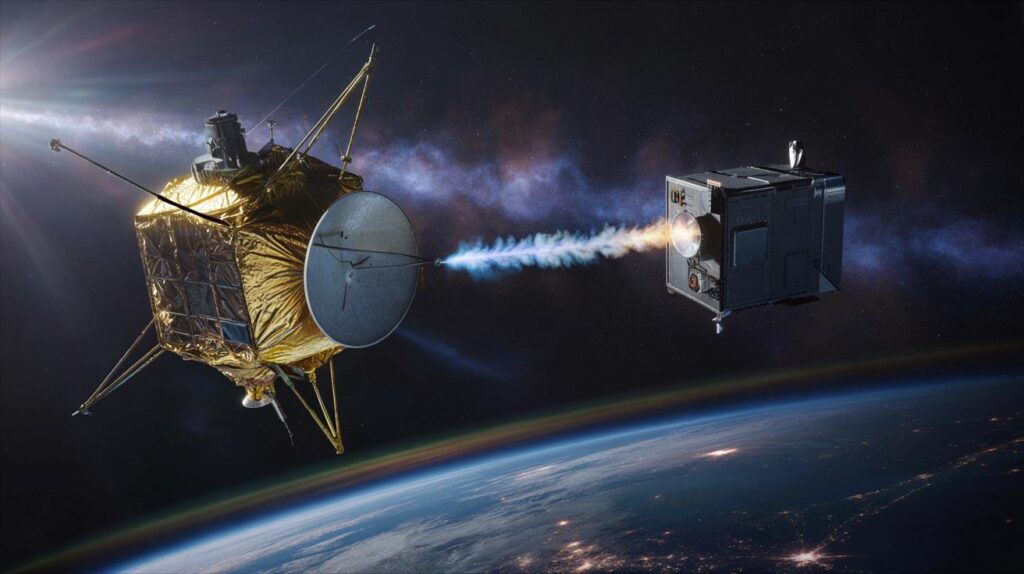It was thought to be long gone, floating silently. Then its orbit changed — influenced by someone, or something — and no one is admitting anything.
I was on a chilly rooftop when the alert came through the group chat. A faint ping from a low-gain antenna, a hint of data on a laptop screen, and then the numbers began to shift. The orbit model for Skynet 1A — a Cold War artifact from 1969 — no longer aligned with the sky, as if the satellite had stirred awake and shrugged. Amateur astronomers exchanged screenshots in the dark, each one revealing a movement that shouldn’t occur on its own. *The sky appeared normal, but the numbers told a different story.*
We’ve all experienced that moment when the familiar map suddenly doesn’t correspond with the road ahead.
What exactly just shifted in the darkness?
Skynet 1A was Britain’s first-generation military communications testbed, a relic that never made headlines — until now. Public orbit data began to indicate a small, sudden change in its trajectory, the kind of shift that suggests a controlled push rather than the gradual drift of time and light. Observers characterized the adjustment as “clean” and “intentional.” **The orbit altered, and not by chance.**
Consider it this way: nature blurs; humans draw straight lines. Within a 24-hour period, multiple independent observers reported that the satellite’s trajectory no longer matched the previous prediction, and the updated solution required a brief, sharp maneuver. Threads on obscure forums lit up with timestamps, star-field images, and concise notes. No one detected a carrier. No one took responsibility. Yet the calculations indicated a guiding hand, however gentle.
Could a spacecraft from 1969 ignite itself after half a century in the cold? It’s not impossible, just highly improbable. Most satellites from that time were “passivated” — tanks vented, batteries secured — before being decommissioned, and residual propellant doesn’t neatly time a burn decades later. Solar pressure and gravity can alter an orbit, but they don’t create a sudden leap in the elements. **That’s not how physics drifts; that’s how hands push.** Which leaves the more unsettling possibility: a stealthy visitor, practicing a rendezvous-and-push on an old, dormant target.
How do you maneuver a 1969 satellite without anyone noticing?
Quietly, systematically, and in the gaps. A space tug approaches using known ephemerides, adjusts relative speed, and employs cameras or lidar to assess distance. There’s no need to latch on with a claw if a light, well-timed push will suffice; even a minor impulse can alter an ancient orbit. We’ve observed large, legitimate versions of this with Northrop Grumman’s servicing vehicles in geostationary orbit, and we’ve seen shadowy counterparts: inspector crafts that hover, test sensors, and slip away.
If you want to track movements like this from your couch, start simply. Obtain public Two-Line Element sets from sources like CelesTrak, input them into an app, and monitor for fits that suddenly deviate. Compare tonight’s pass to last week’s. When the residuals spike, something has changed. Let’s be honest: nobody does that every day. But the community that does — educators, retirees, engineers who can’t let go at midnight — quickly identifies the anomalies, then triangulates with images and timestamps.
When the narrative feels slippery, pay attention to the quiet consensus rather than the loud theories.
“For a derelict from 1969, this appears to be a burn. Small, clean, intentional,” remarked one veteran tracker who has logged thousands of passes. “You don’t achieve that kind of step-change from sunlight and luck.”
- Watch for sudden changes in the fitted orbit, not gradual drift.
- Correlate independent sightings; one data point is merely a rumor.
- Note missed passes and unexpected flares — both can indicate orientation changes.
- Compare before/after ground tracks for pattern disruptions.
- Maintain a log; memory can deceive, logs do not.
Why it matters — and why the silence
Skynet 1A isn’t valuable for bandwidth. It’s valuable as a test subject. Moving an old military satellite allows someone to rehearse delicate choreography with minimal diplomatic repercussions. It also conveys a message to anyone observing: we can reach what you leave behind. Nations with active “inspector” spacecraft are already familiar with the playbook, and others are catching up. When both the owner and the mover remain silent, we are left to interpret the aftermath.
This isn’t the first instance of a mystery satellite approaching a neighbor, or relocating an object to a safer orbit. China’s Shijian-21 towed a defunct craft to a graveyard orbit. Russia’s Luch/Olymp-K has approached commercial satellites like a curious neighbor peeking over a fence. The distinction here is the age of the target and the absence of public explanation. It feels like a rehearsal in plain sight, utilizing a relic that still bears a military insignia.
There’s a safety aspect as well. Unannounced maneuvers complicate traffic management in already congested skies. Space law is sparse when it comes to silent service calls on someone else’s hardware, especially relics. Liability rests with the registered owner, but accountability becomes murky when a third party nudges the ghost. **Someone wanted Skynet 1A relocated.** No notice to operators. No press release. Just a neat little maneuver that leaves a clear line on a chart and a more ambiguous one across the norms.
Skynet 1A did what defunct satellites aren’t supposed to do: it altered the narrative. That narrative could be mundane — a minor gas release from an aging tank, a fluke in the fit — or it could represent a quiet chapter in a new era of close spacecraft choreography. The eeriest aspect isn’t the movement. It’s the silence. Perhaps the United Kingdom knows precisely what occurred and chooses not to share. Perhaps another nation conducted a drill and selected a vintage target to keep tensions low. Or perhaps a commercial servicer attempted something that wasn’t included in the brochure. The sky keeps its own secrets, and so does the ground.
| Key Point | Detail | Reader Interest |
|---|---|---|
| Skynet 1A’s sudden orbit change | A small, sharp shift consistent with a controlled maneuver | Indicates a likely human action rather than natural drift |
| Possible movers and methods | Inspector crafts, space tugs, gentle “push” instead of capture | Clarifies how a 56-year-old satellite could be nudged today |
| Why it matters | Signals, norms, and stealth rehearsals in crowded orbits | Helps readers understand the strategic stakes behind a quiet maneuver |
FAQ :
- Who owns Skynet 1A today?The satellite remains a UK-registered military asset from the original Skynet program, even though it’s long inactive.
- Can a spacecraft from 1969 really move on its own?It’s theoretically possible but highly unlikely after decades. Sudden, clean changes typically indicate an external nudge.
- Could this be a data error?Inaccurate fits can occur. Multiple independent observations over several passes reduce that risk and make a real maneuver more plausible.
- How would a “space tug” move it without grabbing it?By matching speed and applying a controlled, gentle push or using subtle forces; even tiny impulses can alter an orbit.
- Should we be concerned about collisions?Unannounced maneuvers increase risk and complicate tracking. Transparency and coordination help keep the lanes clear.








